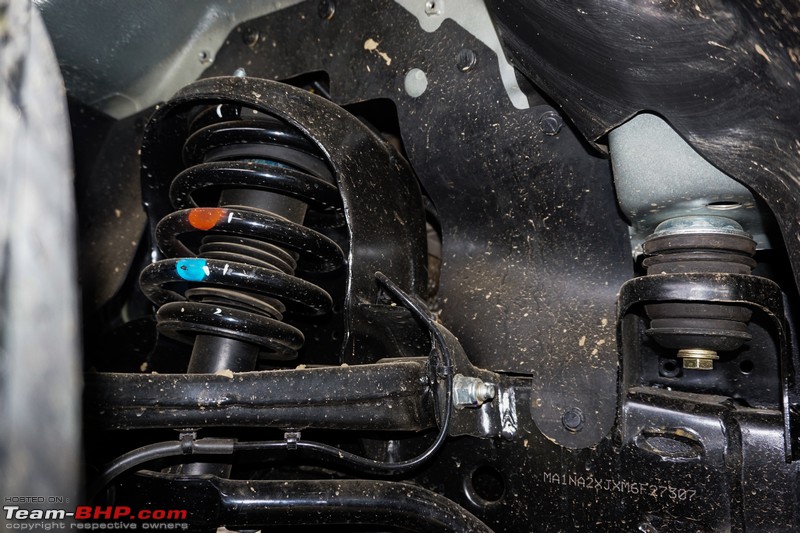| |||||||
| Search Forums |
| Advanced Search |
| Go to Page... |
 |
| Search this Thread |  443,855 views |
| | #1 |
| Team-BHP Support  Join Date: Apr 2016 Location: Mumbai
Posts: 2,920
Thanked: 29,289 Times
| Mahindra Bolero Neo Review The Mahindra Bolero Neo has been launched in India at a price of between Rs. 8.48 - 10.00 lakhs (ex-showroom, Delhi). Mahindra Bolero Neo Pros• A 7-seater SUV at a price comparable to 5-seat crossovers & compact sedans • Robust, abuse-friendly build & body-on-frame construction. A typical Mahindra UV in that sense • Likeable & roomy cabin. 1st & 2nd seat rows are spacious • 1.5L diesel offers excellent urban driveability & fuel economy • Tall seating, comfy front seats with armrests, excellent visibility & good presence make city driving easier • Healthy boot space with the last row of seats folded. Can drop 2nd row to haul more cargo • New additions such as the mechanical locking differential & cruise control • Dual airbags, ABS + EBD, Corner Braking Control etc. are offered on every variant Mahindra Bolero Neo Cons• 3-cylinder diesel has no top-end. Expressway performance is mediocre, vibrating gear lever a turnoff • Ride quality is nowhere as cushy as its car-based rivals. Does get bouncy & bumpy • Steering is on the heavier side at parking / low speeds • No automatic in a market that loves its ATs. No 4x4 or petrol engine either • Deletions from the TUV300 = reversing camera, leatherette seats, lumbar support adjustment, underseat storage, roof rails, smaller fuel tank... • Side-facing 3rd row seats are very uncomfortable • Some important features missing (climate control, Android Auto / Apple CarPlay, rear a/c vents, good speakers, auto-dimming IRVM etc.) • Mahindra's after-sales service quality is a hit or miss. Remains a gamble IntroductionThink of the Bolero Neo as an improved TUV300. The TUV300 was actually a good car and in 'Plus' guise with that 2.2L mHawk under the hood, GTO commented that it was even superior to the Scorpio. But Mahindra botched the original launch of the TUV300 up with an under-powered engine, poor NVH, heavy steering & bouncy ride quality. Worse still, Mahindra introduced the AMT automatic before it even understood the new technology. The end result was a long line of infuriated TUV300 AMT customers who had to contend with awful reliability & breakdowns. The larger TUV300 Plus variant with the 2.2L mHawk was impressive, but it was too little, too late and was never marketed properly. The TUV300 ended up selling in mediocre 1,000 - 1,500 sales numbers every month. Mahindra stopped selling the TUV300 since the introduction of the BS6 emission norms in April 2020. Now, the SUV has been relaunched with some updates and a new name - Bolero Neo. The trend of naming an upcoming product with a successful moniker is something we have been seeing recently. Ford named its new electric crossover the 'Mustang Mach-E' and Tata did the same with the new 'Safari', which is essentially a 7-seater Harrier. The 'Bolero' brand is enormously powerful, especially in rural & semi-urban areas. Whether this works or not depends on Mahindra's sales & marketing machinery. The Bolero Neo gets the BS6-compliant version of the mHawk100 (100 BHP, 260 Nm) engine and 5-speed manual gearbox from the TUV300 facelift that was introduced in 2019. Mistake #1 already is not giving the awesome 2.2L mHawk to the Bolero Neo. A 3-cylinder 100 BHP motor is nothing to write home about, especially for such a heavy UV. Mahindra Bolero Neo Price & BrochureMahindra is offering the Bolero Neo in three variants - N4 (Rs. 8.48 lakh), N8 (Rs. 9.48 lakh) & N10 (Rs. 10.00 lakh). There's an N10(O) variant as well, but its price hasn't been revealed as yet. Weird. The only additional feature on the optional variant is a Mechanical Locking Differential (MLD). You can download the Mahindra Bolero Neo brochure here - Mahindra Bolero Neo Brochure.pdf. Since the Mahindra TUV300 has already been reviewed by Team-BHP, this report will only focus on changes made to the Bolero Neo. To read the full review, click here. ExteriorThe Bolero Neo is based on Mahindra's third-generation platform that's shared with the Scorpio. It measures 3,995 mm in length, 1,795 mm in width and 1,817 mm in height with a wheelbase of 2,680 mm and a laden ground clearance of 160 mm. Overall build quality is as you would expect from a Mahindra. It feels sturdy and ready to take abuse: 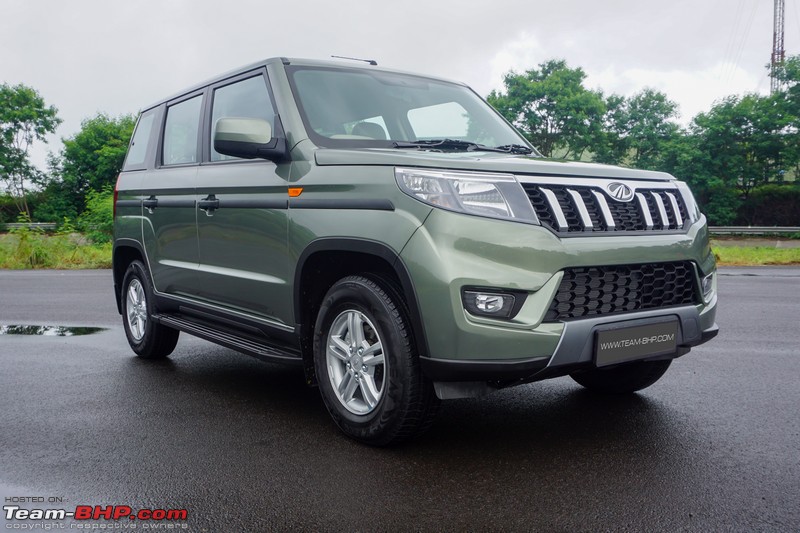 There have been quite a few changes made to the front end to help differentiate the Bolero Neo from the TUV300. Where the TUV300's 'battle tank inspired' design felt like it was trying too hard, the Bolero Neo feels fresher. You have a lot less body colour and the elements don't look oversized. The redesigned bumper gets more creases and also wear a faux skid plate at the bottom: 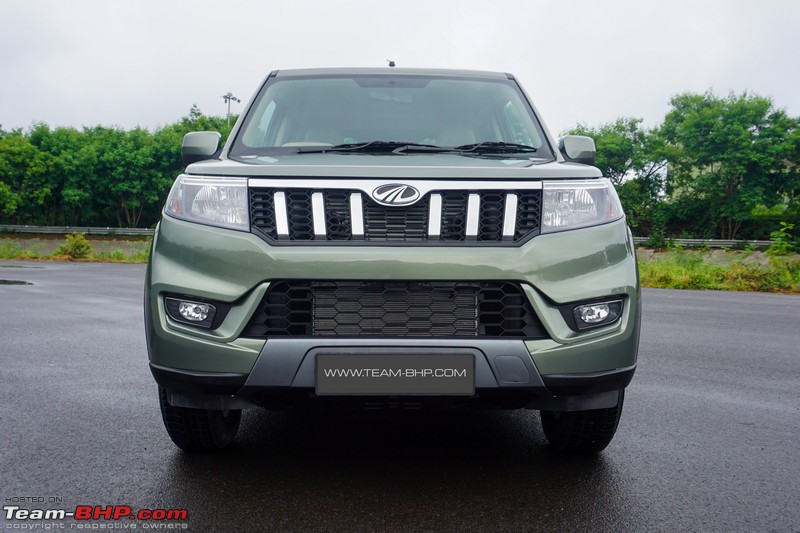 Being a body-on-frame Mahindra, the Bolero Neo is definitely on the heavier side. While most of the other compact SUVs weigh in the ~1.2-tonne range, the Bolero Neo has a kerb weight of 1,555 kg (N4 variant). The power-to-weight ratio is merely 65 BHP / ton (now you know why we want the option of the 2.2L mHawk like in the TUV300 Plus): 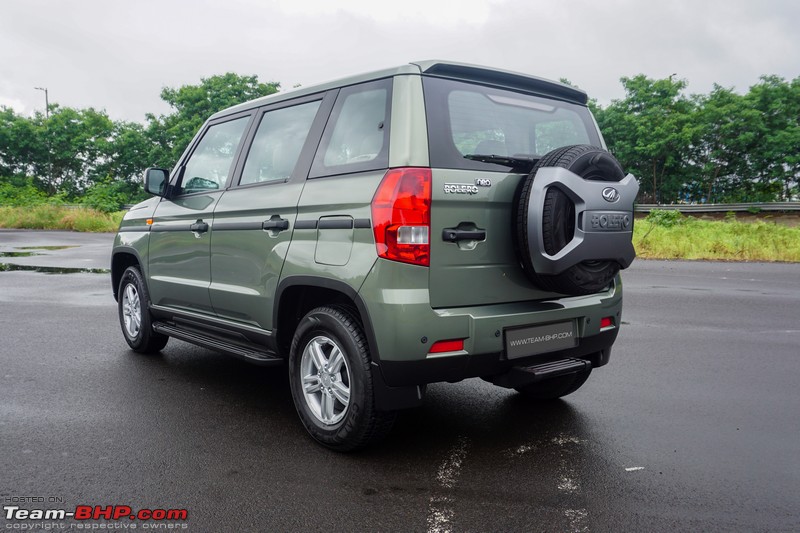 The rear is almost identical to the TUV300 except for the obvious Bolero Neo badging and some minor changes: 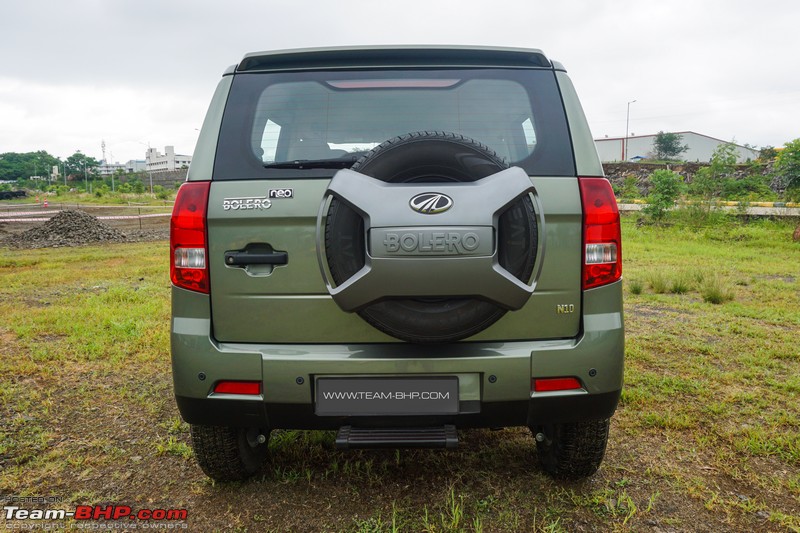 Black side strips have been a signature element of the Bolero, and now the Bolero Neo gets them too! C-pillar is finished in black, while the D-pillar is finished in the body colour - it was the other way round in the TUV300. The door handles are finished in black and plastic cladding around the wheel arches + sides enhances the car's rugged look: 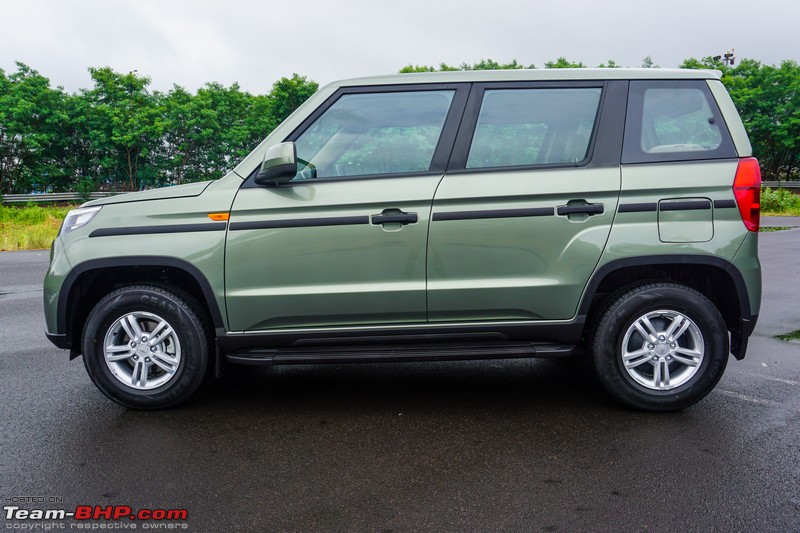 Sleeker headlamp clusters look well proportioned. They get DRL strips at the top and static bending lights:  Bolero-like radiator grille sits in between the headlamps. It gets a honeycomb mesh pattern and 6 vertical chrome slats:  Gone are the big square fog lamps. Instead, you get these smaller oval units in black housings. There are a lot more design elements surrounding the fog lamps: 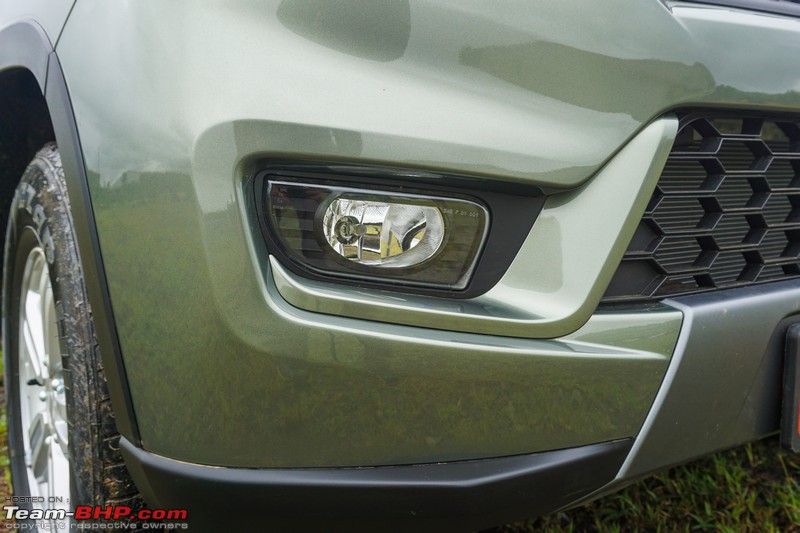 The big air dam at the bottom has a honeycomb mesh grille below which, there is a faux grey skid plate: 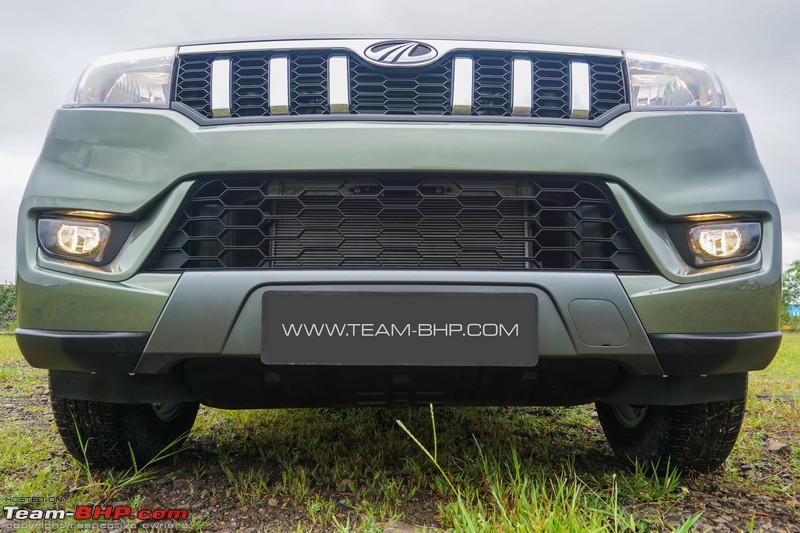 B & C-pillars are finished in black and you get this vinyl on the window line that adds a merging effect into the body colour. Looks cool from a distance, but the finishing could've been better: 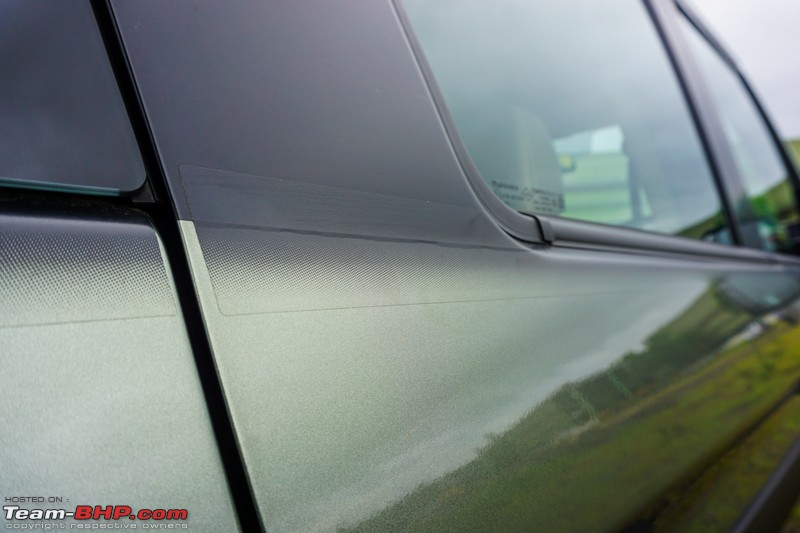 215/75 Ceat Czar tyres are retained. The 15-inch alloy wheels get a simpler design that looks better compared to the TUV300's original rims:  The roof is ribbed for added rigidity, but misses out on roof rails from the TUV300 (reference image): 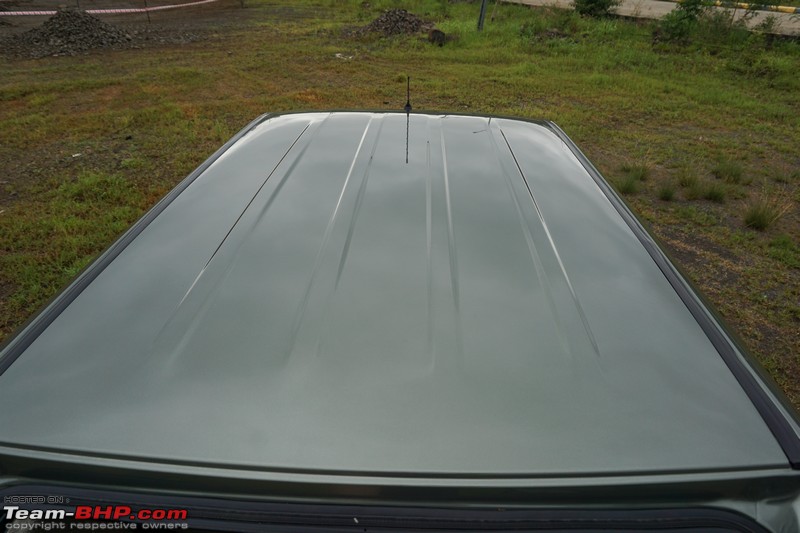 N8 and N10 variants get a roof spoiler:  Tailgate-mounted spare wheel cover gets the mighty Bolero branding. Door handle is finished in black. 'Bolero Neo' badge sits in the top left corner of the tailgate; Neo means new or a modern version of something, so you know what Mahindra is hinting toward: 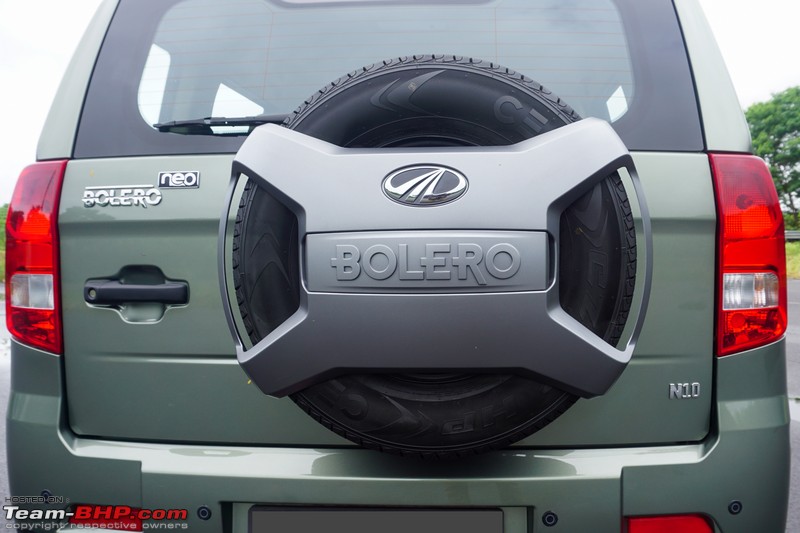 The lower part of the bumper is finished in black and the rear footstep is not foldable: 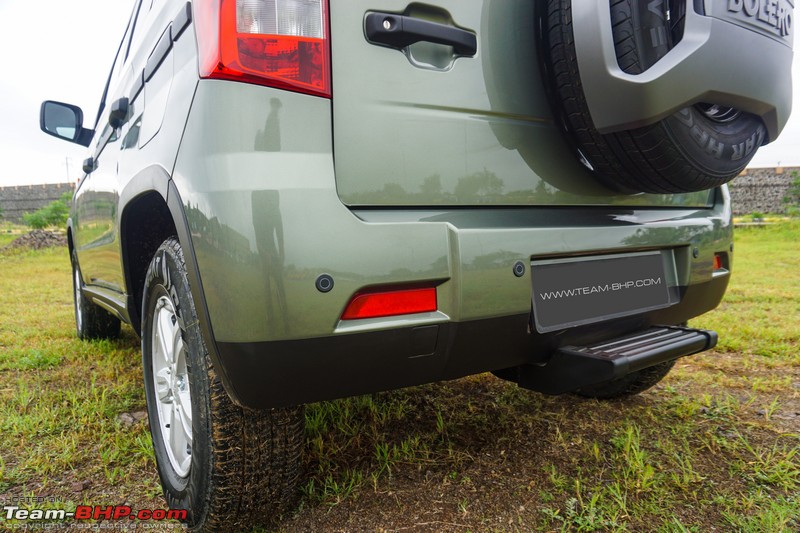 There are 2 shades of white available on the Bolero Neo - Diamond White (N4 & N8 variants) and Pearl White (N10 & N10(O) variants). The one in this picture is the Pearl White colour: 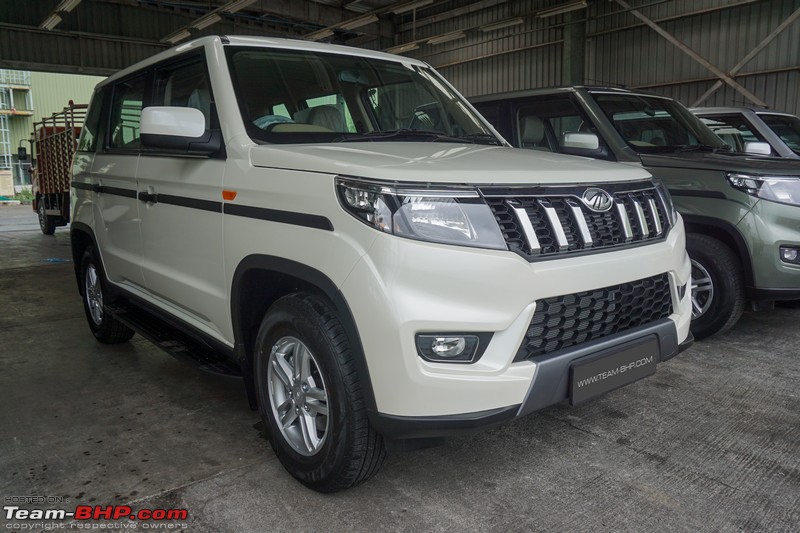 Apart from the white shade, the Bolero Neo is offered in Napoli Black, Highway Red, Rocky Beige (our test car) and Majestic Silver (below): 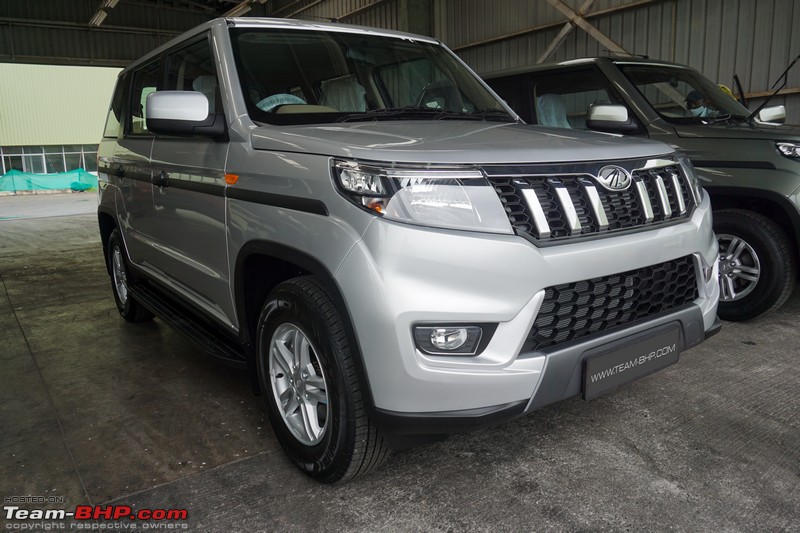 Last edited by Aditya : 22nd July 2021 at 14:19. |
| |  (55)
Thanks (55)
Thanks
|
| The following 55 BHPians Thank Omkar for this useful post: | Aditya, AdityaDeane, Akshay6988, amit1agrawal, arun1100, ashis89, ashking101, bblost, Big Smoke, BlackPearl, CEF_Beasts, chinmaypillay, debuda, digitalnirvana, drrajasaravanan, Dry Ice, Encyclopedic, GTO, gunin, Iksvaku, InControl, jono213, KPR, museycal, N33raj, NerdSpeaks, P21, PM - B, PraNeel, PrasunBannerjee, pratikmantri, procrj, Puffdamgcdragon, PVS, Rambo-RS, ramnaresh_2000, RavenAvi, Researcher, Rigid Rotor, Rock On, Samba, sayakc, shancz, sierrabravo98, StepUP!, swiftnfurious, theexperthand, The_Outsider!, Thyag, Ultim8, Viju, Vinod_nair, Voodooblaster, vredesbyrd, Vysakh |
| |
| | #2 |
| Team-BHP Support  Join Date: Apr 2016 Location: Mumbai
Posts: 2,920
Thanked: 29,289 Times
| InteriorThe cabin of the Bolero Neo is largely similar to that of the 2019 TUV300 facelift. The overall design is simple and straightforward. It looks pleasant & functional: 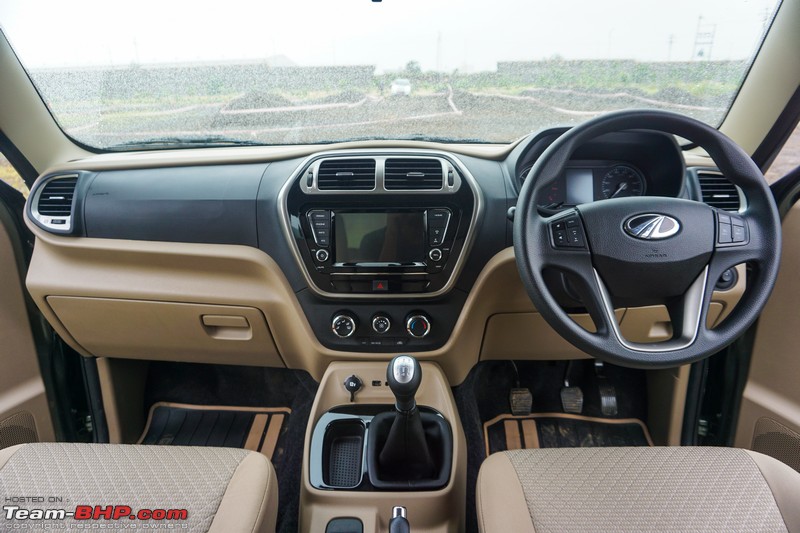 Steering wheel is identical in design to the outgoing car. Gets buttons to operate the cruise control on the right spoke:  One of the major changes on the inside is the new instrument cluster. The upmarket unit with chrome-ringed dials has been replaced by a simpler-looking cluster with a new MID: 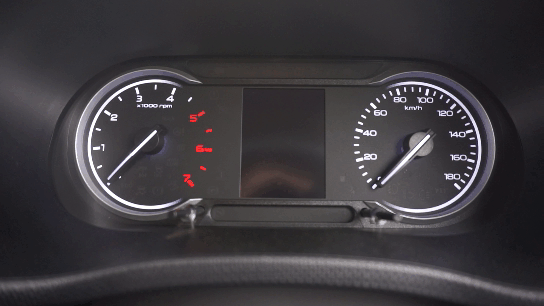 MID is controlled via two stalks at the bottom and displays all the basic information such as an odometer, 2 trip meters, digital speedometer, system warnings, average fuel efficiency, etc. The display is clean and crisp and looks nicer than the previous version's calculator font (reference image):  7-inch touchscreen head-unit supports Mahindra's BlueSense App. However, Android Auto and Apple CarPlay are not supported! Disappointing:  Mahindra offered leatherette seats on the TUV300 Plus and also the 2019 TUV300 facelift (reference image). But in the Bolero Neo, you get fabric seats that not only get soiled quite easily, but just don't feel that premium. Moreover, Mahindra has removed the manual lumbar support (reference image) and the under-seat storage (reference image) in the Bolero Neo: 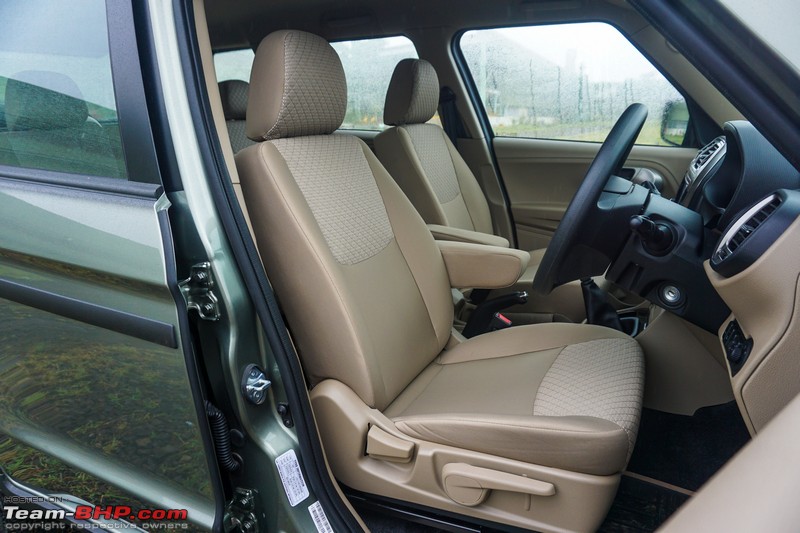 The roof lamp is carried over from the TUV300, but there's a change in the design of the Bluetooth mic:  The flippy key looks premium and is shared with the Thar & Marazzo:  The rear bench is pretty much flat. Space is fair for a sub-4 meter vehicle: 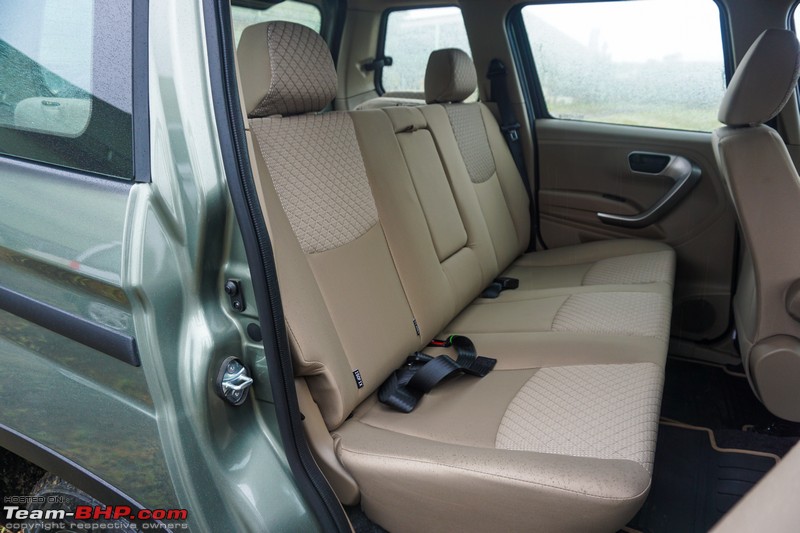 This is me (5'10" tall) seated behind my own driving position: 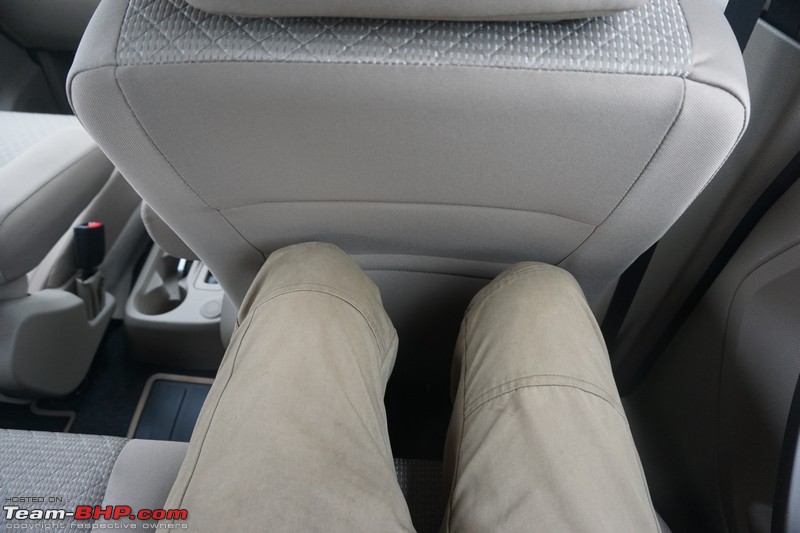 Only one child seat can be fitted on the rear seat bench:  The middle row gets this cheap-looking roof light. The TUV300 had a more upmarket unit (reference image):  Tailgate gets a low-budget cover on the inside. It loses the full cladding with the useful storage pockets + bottle holder from the TUV300 (reference image):  Instead, you get a simple seatback pocket behind the second row. The third row of seats is the same as before: 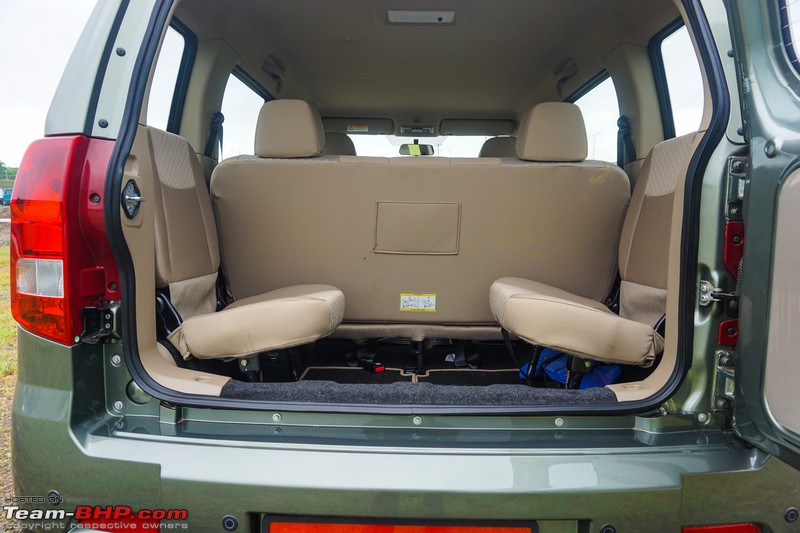 Last edited by Aditya : 17th July 2021 at 09:31. |
| |  (63)
Thanks (63)
Thanks
|
| The following 63 BHPians Thank Omkar for this useful post: | Abhi_abarth, Aditya, AdityaDeane, airbus, Akshay6988, amit_purohit20, Arnav Vaghela, ashking101, Avikbrio, bblost, Big Smoke, BlackPearl, CEF_Beasts, chinmaypillay, condor, cs_rajesh, digitalnirvana, drrajasaravanan, Dry Ice, Emvi, govindremesh, GTO, H0RSEPOWER, Harjot37, hdman, Iksvaku, InControl, Kosfactor, mh09ad5578, museycal, N33raj, NerdSpeaks, P21, PM - B, PraNeel, PrasunBannerjee, procrj, psispace, Puffdamgcdragon, Rambo-RS, ramnaresh_2000, RavenAvi, Researcher, Rigid Rotor, Rock On, Roy.S, Samba, sarav100, shancz, sierrabravo98, sknair, supertinu, swiftnfurious, Tgo, theexperthand, The_Outsider!, Turbanator, Viju, Voodooblaster, vredesbyrd, Vysakh, Wason4699, WhiteSierra |
| | #3 |
| Team-BHP Support  Join Date: Apr 2016 Location: Mumbai
Posts: 2,920
Thanked: 29,289 Times
| Driving the 1.5L Diesel MTThis mHawk100 1.5-litre, 3-cylinder diesel engine makes 100 BHP @ 3,750 rpm and 260 Nm @ 1,750 - 2,250 rpm. A 5-speed manual gearbox transmits power to the rear wheels: 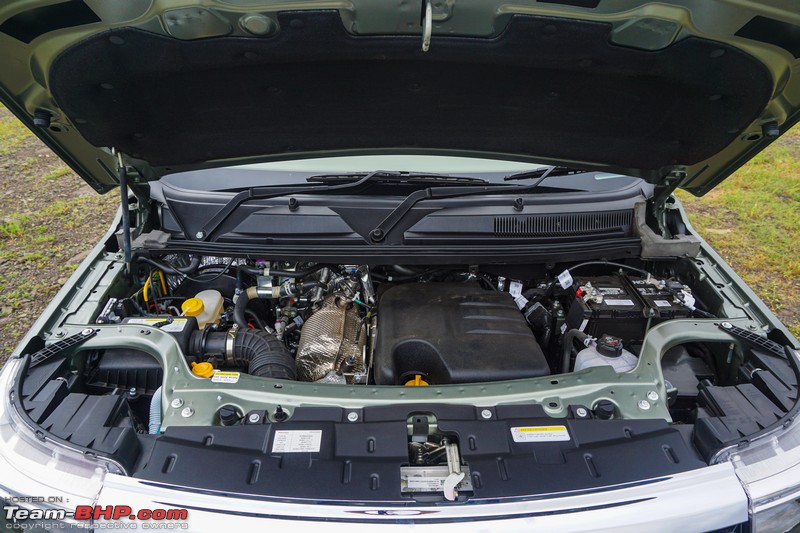 Mahindra replaced the mHawk80 with the mHawk100 when it introduced the 2019 facelift of the TUV300. But as mentioned earlier, they should've brought in the 2.2L mHawk120 for the Bolero Neo's higher variants (like the TUV300 Plus). Here, you get the same mHawk100 engine mated to a 5-speed manual transmission sending power to the rear wheels. However, there's one difference in the Bolero Neo = the 2-stage turbocharger of the TUV300 has been replaced by a Variable Geometry Turbocharger (VGT). While the 2-stage turbocharger worked well, the VGT is better. In simple terms, the 2-stage turbo has 2 scrolls - a small one (for low rpms) and a large one (for higher rpms). A variable geometry turbocharger has adjustable vanes inside that move according to the power needs. Theoretically, a VGT is designed to increase boost pressure at low speeds, reduce response times / lag, increase available torque, decrease the boost at high engine speeds to prevent over-boosting and lower engine emissions. The VGT has resulted in the Bolero Neo making 20 Nm more than the 2019 TUV300 (240 Nm). It doesn't take much time to realize what this engine has been designed for - low to medium speed driveability. The engine's tune is very practical for city commuting. Torque at low rpms is superb and you won't be downshifting too much in the city. This engine feels very tractable and you can shift up early if you wish. The mHawk 100 isn't a revv happy unit, but it certainly isn't under-powered for city use, thanks to the 260 Nm of torque and the variable geometry turbocharger. Slot into 3rd gear and even at 20 km/h, the pick-up is effortless. While the torque figure is impressive, the real gem is the rpm it delivers it at (1,750 - 2,250 rpm). While driving, you will notice the Bolero Neo start pulling from ~1,000 rpm without much effort. At the offroad trail of the Mahindra test track, a series of big bumps were cleared without any throttle input or clutch modulation! Drive your way through city traffic onto the highway, and you'll soon realize this isn't a hound hungry for high speeds. The engine's behaviour is at its best between 2,000 - 3,700 rpm. Revving it beyond that feels futile as there's nothing to offer at high revvs. Try to take it above 4,000 rpm and all you get is a lot of noise with no real progress. While performance up to 100 km/h is very acceptable, it slows down beyond that. High speed overtakes need to be well planned. You can feel the Bolero Neo running out of breath after 120 km/h. Sometimes, you'll move into the fast lane to overtake a vehicle and it's like the Bolero Neo hits a wall. Slamming the pedal down won't give you that much needed surge. On the expressway, it's best to drive the Bolero Neo in a conservative manner. Move out of the fast lane and cruise. 100 km/h in 5th gear sees the tachometer touch 2,500 rpm, while 120 km/h comes up at 3,000 rpm. Yes, the 5th gear is much shorter than we would have liked!! Other diesel SUVs usually see 100 km/h at 2,000 - 2,200 rpm. This was probably done while keeping the small engine, vehicle weight + 7 occupants in mind. Apart from the moderate power output of the engine, what holds the Bolero Neo back is its sheer weight. At 1,555 kg, the body-on-frame Bolero Neo is significantly heavier than the monocoque competitors that weigh ~1,200 kg. This weight affects performance, dynamics and fuel efficiency. To help bump up the fuel efficiency figures, Mahindra has installed a host of features such as an engine economy mode, A/C economy mode and engine start/stop system. Like most Mahindras out there, the long-throw gear lever has a rubbery side to it. The shifts aren't slick and boy, does the gear lever vibrate! If you've driven other body-on-frame UVs, you won't complain. Those upgrading from a sedan will find it rather agricultural to operate. The Bolero Neo deploys a dual-mass flywheel. The clutch pedal has a longer throw than the typical C1 & C2 segment crossover. One useful addition in the Bolero Neo is the Mechanical Locking Differential (MLD) or, as Mahindra calls it, 'Multi Terrain Technology'. This system is convenient on horrible surfaces where one of the rear wheels loses traction. It utilises a flyweight mechanism & engages when a difference of 100 rpm or more in wheel speeds is detected between the left and right (rear) wheels. This is when the system sends power to the other wheel automatically. You can hear the lock engage on the free rotating wheel in the video below: Noise, Vibration & Harshness (NVH)Start her up and the Bolero Neo shakes quite a bit. Vibrations at start-up are what you'd expect of a 3-cylinder diesel and can easily be felt through the gear lever, pedals and steering. Even at idle, the gear lever shakes like a pup after a bath. Vibrations are further evident when you switch the engine off (the whole car shakes about). NVH levels are liveable, but certainly not on par with its modern rivals. It's a typical Mahindra UV in that sense. The diesel is audible on the inside even at idle. As long as you stay below 3,000 rpm, the engine note won't annoy you. At higher revs, it will. Vibrations through the steering wheel and gear lever are constant, while vibrations on the clutch pedal are directly proportionate to the rpm level. Wind noise does seep in when the speedometer needle hovers around 100 km/h. Mileage & Fuel EconomyMahindra hasn’t shared the ARAI figures for the mHawk100 in the Bolero Neo. But considering the fact that it is powered by a small 3-cylinder diesel, its fuel economy should keep owners happy. On a related note, the fuel tank size is 50 litres (10 litres less than TUV300). Ride ComfortNo, the ride quality isn't plush. Mahindra's body-on-frame UVs have never been cushy and the Bolero Neo is no different. Urban ride quality is just about acceptable, but you are always aware of the road conditions below you. At low speeds, larger undulations will see occupants being tossed about as the body moves from side to side. Take the same bumps at high speed and the Bolero Neo tackles them better. Yep, the suspension takes uneven roads better at high speed than low. On the highway, you won't even slow down for broken tarmac. On the joints of the Mumbai-Pune expressway though, the Bolero Neo had a tendency to bounce (albeit lesser than the old Scorpio). Those on the last row will feel it even more. Let's be clear on one thing - this is no comfort-oriented monocoque UV. Note that the suspension will most likely get more pliant with passengers on board. The Bolero Neo gets a double wishbone suspension up front and rigid axle multi-link suspension at the rear and offers terrific bad-road ability. Rough patches, broken bits of road and dirt tracks are no problem for the Bolero Neo. In this area, the Bolero Neo has that classic Mahindra DNA. It feels very abuse-friendly and there's a certain robustness felt when tackling rural roads. It's as if the chassis & suspension were built for those kind of roads. A laden ground clearance of 160 mm does help in this aspect. An approach angle of 28-degrees (TUV300 had a better approach angle of 31-degrees) and a departure angle of 35-degrees make things easier when the going gets rough. Handling & DynamicsOut on the open road, we found that grip levels are satisfactory. Even the OEM tyres don't squeal excessively. Of course, you must always keep its weight & body-on-frame build in mind. This is a tall ladder-frame vehicle and behaves like one. It actually feels like a smaller Scorpio. Push a little hard and body roll sets in, even with the front and rear anti-roll bars. Body roll is very evident in the curves and it will make you back off the accelerator. Goes without saying that you shouldn't treat the Bolero Neo like the Sonet or EcoSport, which drive like regular sedans in comparison! Straight-line stability is good and you can comfortably cruise at 110 km/h all day long. SteeringThe Bolero Neo gets a hydraulic power steering. The steering is quite heavy at parking speeds and does require a certain amount of effort. You will notice the difference vis-à-vis an electric steering that the monocoque crossovers use. At speed, the steering has enough weight and there is no nervousness. It's not precise by any means, but it gets the job done. The 5.35 meter turning radius is wide for a sub-4 meter vehicle and making U-turns in narrow by-lanes will warrant a 3-point turn. Well, some crossovers like the EcoSport (5.3 m) aren't much better in this area. BrakingStopping power comes from disc brakes up front and drums at the rear. They're standard-fare in terms of performance. Still, the pedal feels rather spongy. Variable Geometry Turbocharger placed next to the engine: 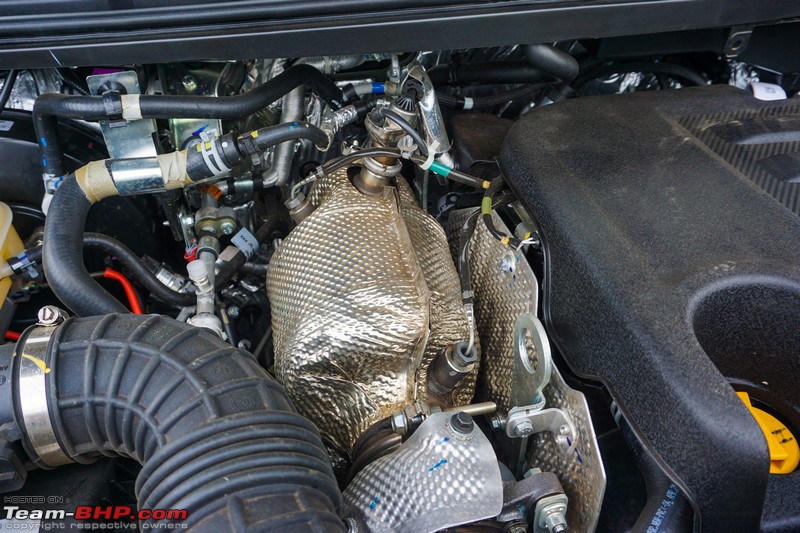 Fuel tank capacity has gone down by 10 litres to 50L: 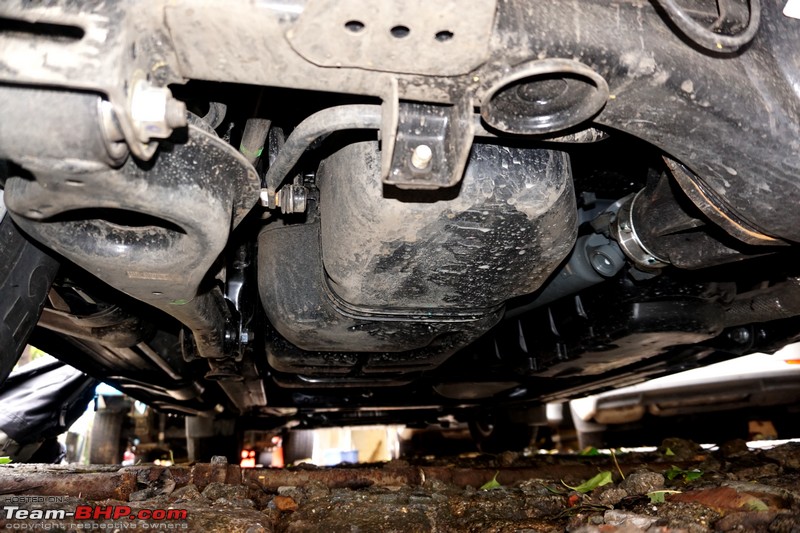 Last edited by GTO : 22nd July 2021 at 19:37. |
| |  (23)
Thanks (23)
Thanks
|
| The following 23 BHPians Thank Omkar for this useful post: | AdityaDeane, Arnav Vaghela, ashis89, BlackPearl, CEF_Beasts, Dry Ice, GTO, gunin, Iksvaku, JithinR, Mustang Sammy, Punatic, Rambo-RS, Researcher, Rock On, Roy.S, rsjagtap, saikarthik, SchumiFan, sinhead, supertinu, swiftnfurious, Voodooblaster |
| | #4 |
| Team-BHP Support  | re: Mahindra Bolero Neo Review Thread moved out from the Assembly Line. Thanks for sharing! Last edited by Aditya : 17th July 2021 at 09:33. |
| |  (3)
Thanks (3)
Thanks
|
| The following 3 BHPians Thank Aditya for this useful post: | digitalnirvana, GTO, Researcher |
| | #5 |
| BHPian | re: Mahindra Bolero Neo Review Well documented changes. I feel like M&M has missed an opportunity here. They should have retained the roof rails, they were functional rails and cleaning such a tall boy roof will be a pain. The 3 cylinder engine may sound boring on the paper, but trust me it has enough grunt to pull 5 adults + 2 children and their luggage on roof and still maintain it's character at 100+ speeds. Even though a more refined 4 cylinder engine would have made a great difference. The AMT is a world class failure and all previous AMT owners (including myself) will have enough horror stories to share. I myself may have costed M&M many customers, as I have not recommended this vehicle to any prospective buyers who inquired me. I always said not to buy it and directed them to other sorted vehicles. Space wise and road presence wise it is a monster. No other vehicle in it's segment can beat it. Just a name change will not make much difference to this vehicle. The market has already declared it as a flop model. Owners can forget about resale value, but if you want a rugged BOF SUV for rural roads then you cannot go wrong with Bolero Neo. |
| |  (33)
Thanks (33)
Thanks
|
| The following 33 BHPians Thank ramnaresh_2000 for this useful post: | AdityaDeane, Akshay6988, amit_purohit20, arun1100, ashishk29, ashking101, bblost, CEF_Beasts, chinmaypillay, DieselTorq, digitalnirvana, fighterace, frewper, gauravanekar, GTO, H0RSEPOWER, InControl, JithinR, krish3, LoneRidder, nkaru, RaceHorse, Raghu M, RavenAvi, Samba, swiftnfurious, TaurusAl, Turbanator, Vijin, Viju, Voodooblaster, WhiteSierra, Zinda |
| | #6 |
| Senior - BHPian Join Date: Mar 2020 Location: Pune
Posts: 1,955
Thanked: 5,777 Times
Infractions: 0/1 (7) | re: Mahindra Bolero Neo Review This new Bolero sure looks a bit more polished (from outside), however, I preferred the TUV300's interior. Except the MID, the TUV300 had a slightly more premium feel IMO. I always wondered how much does the height being more than the width affect the stability of the car? WagonR and TUV300/Bolero Neo are the only cars in India that continue with this trend. Shouldn't these vehicles be a very handful around the twisties, with a high risk of toppling? Or is it not that apparent? |
| |  (7)
Thanks (7)
Thanks
|
| The following 7 BHPians Thank 07CR for this useful post: | chinmaypillay, InControl, nkaru, ramnaresh_2000, RedTerrano, sainyamk95, sarav100 |
| | #7 |
| BHPian Join Date: Jul 2020 Location: Kottayam,DXB
Posts: 634
Thanked: 2,977 Times
| re: Mahindra Bolero Neo Review TUV was always better than Bolero, now it's much more better. In some cities it's even cheaper than Bolero, also much more powerful, modern and safer. But is that what a Bolero customer looking for? Nobody knows, not even Mahindra. Removing Bolero from showrooms temporarily will give the push NEO deserves, coupled with better incentives for sales staff and warranty, maintenance package over Bolero will give NEO a better traction. The sales representative package plays a significant role in the retail sales. I do remember when I was taking test drive of Marazzo back in 2019, the sales rep kept on saying that the car is just for cabs, you should look at XUV instead. The pricing is ultra VFM by today's standards. Wishing Mahindra all the very best, will be glued on to the sales figures of this one before recommending it. Remove those jump seats and send it to GNCAP, bag a 4 star rating ASAP. Last edited by TorqueIndia : 17th July 2021 at 11:50. |
| |  (6)
Thanks (6)
Thanks
|
| The following 6 BHPians Thank TorqueIndia for this useful post: | AdityaDeane, cs_rajesh, digitalnirvana, GTO, ramnaresh_2000, Voodooblaster |
| | #8 |
| BHPian Join Date: Nov 2010 Location: Chennai
Posts: 326
Thanked: 491 Times
| re: Mahindra Bolero Neo Review The outgoing Bolero was much more 'butch-styled' and looked rugged. I feel the M&M engineers picked a bit more inspiration from their own TUV than what should have been optimal. As someone said above, a good chance to uplift the Bolero image has been squandered. Cheers! |
| |  ()
Thanks ()
Thanks
|
| | #9 |
| Senior - BHPian Join Date: Oct 2020 Location: Magic land
Posts: 1,057
Thanked: 4,432 Times
| re: Mahindra Bolero Neo Review Felt like they should have given a proper automatic transmission option with this car. It is something that still makes me wonder. After all it is not rocket science and Mahindra has done it with the likes of the Scorpio, Thar etc. Also what is the deal with those third row seats ? I thought those were not permissible now, especially with the lack of a proper headrest. Overall the car looks decent with nice interiors. Hope this can bring in the numbers Mahindra hopes. |
| |  (1)
Thanks (1)
Thanks
|
| The following BHPian Thanks TrackDay for this useful post: | Emvi |
| | #10 |
| BHPian Join Date: Jan 2021 Location: New Delhi
Posts: 285
Thanked: 2,004 Times
| re: Mahindra Bolero Neo Review |
| |  (4)
Thanks (4)
Thanks
|
| The following 4 BHPians Thank sierrabravo98 for this useful post: | abhishek46, digitalnirvana, TorqueIndia, WhiteSierra |
| | #11 |
| BHPian Join Date: Nov 2018 Location: Hyderabad
Posts: 577
Thanked: 2,819 Times
| re: Mahindra Bolero Neo Review Has the vehicle height decreased? A prominent 5'10 feet reviewer on YouTube stands atleast 3 inches taller than this car when reviewing it. |
| |  (4)
Thanks (4)
Thanks
|
| The following 4 BHPians Thank AirbusCapt for this useful post: | amit_purohit20, digitalnirvana, ramnaresh_2000, unni246 |
| |
| | #12 |
| BHPian Join Date: Jan 2020 Location: Hyderabad
Posts: 242
Thanked: 1,234 Times
| re: Mahindra Bolero Neo Review I really wish Mahindra added android auto, apple CarPlay and a rear camera (even if the image quality is crappy). I mean why include a touch screen and not use it? This car ticks a lot of boxes for me. I can live without the ACC or rear AC vents. However given how convenient android auto is, the lack of it is a glaring omission in my books. Of course, we can always upgrade to a good aftermarket HU, but including a touch screen and not using it is plain stupid on M&M’s part. I really hope they include it in future updates or in the N10(O) variant (unlikely, I know). The rest I can live with. Another omission is the functional roof rails. I mean they had it in the outgoing car, it won’t take much effort to include those since the design has not changed much. I sometimes wonder what M&M’s product planners smoke. Their decisions defy logic. |
| |  (3)
Thanks (3)
Thanks
|
| The following 3 BHPians Thank furyrider for this useful post: | digitalnirvana, ramnaresh_2000, sainyamk95 |
| | #13 |
| Distinguished - BHPian  Join Date: Jan 2015 Location: Chennai
Posts: 1,911
Thanked: 9,082 Times
| re: Mahindra Bolero Neo Review
Ride height has indeed decreased! Most reviewers are mentioning this. This should reduce bodyroll to a great extent...but details are patchy at the moment. |
| |  (5)
Thanks (5)
Thanks
|
| The following 5 BHPians Thank locusjag for this useful post: | AirbusCapt, amit_purohit20, digitalnirvana, GTO, ramnaresh_2000 |
| | #14 |
| BHPian | re: Mahindra Bolero Neo Review M&M deleted below features from TUV 300
Below features added in Bolero Neo
Should have added below
|
| |  (17)
Thanks (17)
Thanks
|
| The following 17 BHPians Thank ramnaresh_2000 for this useful post: | Akshay6988, amit_purohit20, anthusiast, arin_12, arun1100, carfreak7, CEF_Beasts, chinmaypillay, digitalnirvana, GTO, InControl, RaceHorse, RavenAvi, sainyamk95, swiftnfurious, theqca, Torque_Curve |
| | #15 |
| Senior - BHPian Join Date: May 2019 Location: Kozhikode
Posts: 1,283
Thanked: 5,731 Times
| re: Mahindra Bolero Neo Review I thought the whole point of Bolero Neo was to make Bolero appeal to the next generation who wanted a bit more refinement. If that was the idea, why skip Android Auto and Apple car play? That single feature has the ability to tilt buyer preferences. It can take Bolero Neo into the consideration set of even a Nexon buyer. Other than that it is a good package from the reviews. I wish they correct this soon. I am surprised Mahindra, who is known for packing the cars every feature, decided to omit this one. |
| |  (4)
Thanks (4)
Thanks
|
| The following 4 BHPians Thank padmrajravi for this useful post: | digitalnirvana, GTO, InControl, sainyamk95 |
 |



